Abstract
This research study aims to investigate the feasibility of incorporating high-density polyethylene waste (HDPEW) into bitumen applications. Two conventional conditions of bitumen, namely, aged bitumen (AB) and virgin bitumen (VB), are rejuvenated and modified, respectively, using post-consumer HDPEW sourced out of bottle crates. The outcome (Pyro oil, PO-HDPEW) of the pyrolysis thermochemical process is used by 10, 20, and 30% to rejuvenate AB, while the fine-ground granules (FG) (FG-HDPEW) are used by 2, 3, 4, and 5% to modify the VB with different percentages. Physical and rheological characterization testing, including penetration, softening point temperature, and rotational viscosity (RV), is conducted to evaluate the performance of the HDPEW-rejuvenated and -modified binders and optimize both rejuvenator and modifier percentages. In addition, physical and chemical tests, including scanning electron microscopy (SEM), energy dispersive X-ray spectroscopy (EDX), and Fourier transform infrared spectroscopy (FTIR) are conducted to analyze the composition, distribution of surface contaminants, and the molecular structure of the bitumen, based on their respective wavelengths. Moreover, advanced mechanical and rheological tests, including dynamic shear rheometer (DSR), multiple stress creep and recovery (MSCR), and linear amplitude sweep (LAS) tests, are conducted to investigate the susceptibility of the rejuvenated and modified bitumen with HDPEW to rutting and fatigue cracking. The testing results demonstrate that the addition of PO-HDPEW to AB and FG-HDPEW modification of VB can enhance the physical, chemical, mechanical, and rheological properties of bitumen; however, this study recommends further research on the aging performance of the PO-HDPEW-rejuvenated bitumen. This research provides insights into using HDPEW as a cost-effective and eco-friendly rejuvenator and modifier on bitumen properties, which can aid in the longevity and performance of pavements.
1. Introduction
Bitumen is a commonly utilized material in the construction industry, particularly in the construction of roads, bridges, and other infrastructure projects. It is a byproduct of crude oil refining and is a thick and dark-colored hydrocarbon substance with high viscosity. The main application of bitumen is in the construction of roads, where it is mixed with aggregate particles to form bituminous mixtures [1,2]. Bitumen contains two important components: asphaltenes and maltenes. Saturates, aromatic substances, and resins are the main constituents of maltenes [3,4]. When bitumen is aged, the saturate content is decreased due to the oxidation that takes place. This leads to an increase in viscosity and hence yields a harder and stiffer material due to the imbalance in the asphaltenes and maltenes amounts [3,4]. This problem can be overcome by rejuvenating the aged bitumen, which is extracted from reclaimed asphalt pavements (RAP), with recycling agents such as hydrocarbon oils [3,4].
In recent years, using waste materials in infrastructure construction has gained much attention due to the great social, ecological, and economic benefits [5,6]. Although resources are scarce, approximately 110 million tons of bitumen are consumed every year in pavement construction activities worldwide [7,8]. Therefore, massive investments are spent in both developing and developed countries all over the world on the reuse of RAP in pavement construction and maintenance [9]. However, the reuse of such higher RAP amounts in bituminous mixtures, which need to be rejuvenated first, is necessary not only for environmental benefits and sustainability but also to reduce its disposal problems and decrease the pavement life cycle costs [10]. On the other hand, other research efforts have examined the feasibility of using waste polymers as a bitumen modifier [11]. The application of polymer modifiers in bitumen has experienced a significant surge in recent years, as they have proven their effectiveness in mitigating various types of distress in flexible pavements, such as fatigue, rutting, and thermal cracking [12].
Rejuvenation of aged bitumen is an important and trending area of research. Several studies have been conducted to identify different recycling agents, especially from waste, that can effectively rejuvenate the aged bitumen by restoring the maltenes content as their quantity is reduced by aging (oxidation) [10,13,14,15]. While traditional rejuvenators such as soft bitumen, warm mix surfactant, and bio-rejuvenator have been used, new substances such as waste hydrocarbon oils generated by thermal pyrolysis are being explored [16]. The use of waste polymers in modifying bitumen or in rejuvenating extracted aged bitumen from RAP is an environmentally friendly decision [17]. Several studies have reported that the use of waste polymers can improve the performance of bituminous mixtures containing high RAP percentages in comparison to conventional hot mix asphalt (HMA) mixtures [18,19].
The European Commission published a document titled “Roadmap to a Resource Intensive Europe” that highlights the role of waste in improving the economy by 2020 and actually viewing waste as a resource [20]. Recycling plastic waste is substantial for reducing the adverse environmental impacts related to landfills while reducing the use of energy and resources, which are limited, in addition to reducing emissions from the production of new plastic [21].
Thermoplastic polymers are a type of material that can undergo a reversible phase transition from a solid to a molten state when exposed to heat, followed by solidification upon cooling [22]. This property of being able to reform upon heating makes them highly malleable and versatile. In Western Europe, around 80% of used plastics are elastomers that fall under this category, such as polypropylene (PP), low-density polyethylene (LDPE), high-density polyethylene (HDPE), polyvinyl chloride (PVC), polyethylene terephthalate (PET), and polystyrene (PS) [22].
A literature review by Zhao et al. [23] evaluated papers that focused on the use of plastics as solid waste materials in pavement construction between 2014 and 2019 and found that PE and PP polyolefins were the most researched polymers [23]. Despite using the dry process to recycle the plastic into bituminous mixtures, plastic can be introduced directly by the wet method into a hot bitumen (polymer-modified bitumen, PMB). This is completed before being incorporated into mixtures for the production of polymer-modified bituminous mixtures [24]. Polymers are added to bitumen in amounts that range from 1 to 10% by bitumen weight, with the most common range being 3–5% by weight [25]. Alternatively, through the dry process, plastics can be integrated into hot mineral aggregates preceding the addition of bitumen, effectively serving as another aggregate [25].
Recently, there has been growing attention to exploring diverse thermochemical recycling methods for converting plastic solid waste (PSW) into useful products [26]. Thermal pyrolysis, a technique for converting organic matter into useful products through thermal decomposition in an oxygen-free environment, has been identified as one of the promising methods for PSW conversion [22,27,28]. Pyrolysis can be seen as a form of feedstock recycling, as it involves breaking down long-chain organic materials into their constituent components at high temperatures of 500 °C in the lack of air or other reactive agents [29,30]. The absence of oxygen prevents combustion reactions, which include the oxidation of the organic material and the production of carbon dioxide (CO2) and water vapor (H2O) as byproducts. As a result, pyrolysis occurs under conditions of limited or no CO2 production [29,30]. It was reported in 2018 that there were approximately 15 corporations operating 87 factories across the globe to produce petrochemical and chemical raw materials from plastic debris through a thermal pyrolysis technique [31]. In 2021, Hadole et al. [32] produced pyro-oil-modified bitumen by blending pyro-oil high-density polyethylene (PO-HDPE) with base bitumen (VG30). This study revealed no apparent trends in the data analysis for the examined parameters. However, as modified bitumen aged, its work of adhesion decreased while its work of cohesion increased, leading to a higher susceptibility to moisture damage. Moreover, the findings showed that pyro-oil is more effective than base bitumen in enhancing the surface tension parameter under various aging conditions [32].
In the context of bitumen technology, there has been limited research conducted to assess the durability of HDPE-modified binders against fatigue-related degradation and thermal cracking [33]. Polyethylene, a semi-crystalline thermoplastic polymer synthesized through ethylene polymerization, shares a chemical structure with the saturated constituents of bitumen. As is typical of most polyolefins, polyethylene exhibits a slight affinity for interacting with bitumen due to its non-polarity, saturated aliphatic nature, and propensity to crystallize [33]. The molecular structure simulation shows that bitumen consists of four components, as shown in Figure 1a; however, the molecular structure of the analyzed compounds of polyethylene and HDPE prior to pyrolysis is shown in Figure 1b [34,35].
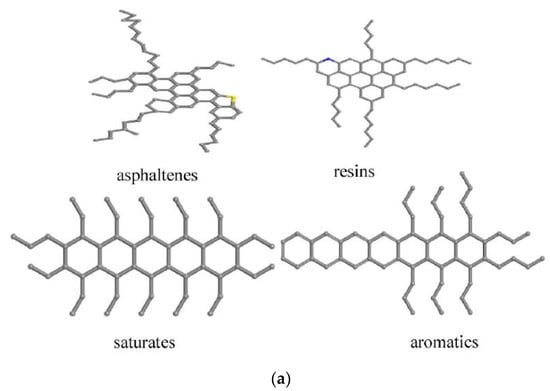
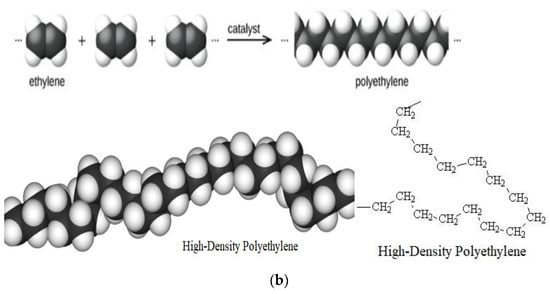
Figure 1.
Models of bitumen main components and HDPE [34,35]. (a) The molecular models of bitumen main components. (b) The molecular model of HDPE.
HDPE has an SPI (Society of the Plastics Industry, Inc.) resin identification code of 2 and its properties can be summarized based on previous research as follows [36,37]:
- (1)
- Melting point in the range of 250–260 °C;
- (2)
- Softening point from 90 °C (approx.);
- (3)
- Transparent, robust, solvent-resistant, and a barrier to gases and moisture.
Various research efforts have been exerted examining the viability of employing HDPE waste as a bitumen modifier [11]. The results show that incorporating waste HDPE into binders improved their resistance to rutting due to the enhanced stability and high molecular weight (MQ) of the modified binders. Moreover, this approach offers an opportunity to recycle plastic waste and contribute to environmental protection [11]. The choice to use HDPE is more economical, considering its wide variety of applications that fall within the properties of other polymers [38]. The research findings indicate that by adding HDPE to bitumen, its capacity to endure deformation at high and moderate temperatures and its resistance to shear is increased. Furthermore, this incorporation leads to an improvement in the Marshall quotient (MQ) and indirect tensile strength (ITS) of bituminous mixtures [39].
Overall, the application of pyro-oil as an aged bitumen state-of-the-art rejuvenator and the use of fine-ground granules of a high-density polyethylene waste (HDPEW) as a modifier for virgin bitumen are promising techniques for improving the properties of bituminous blends. These methods provide an opportunity to recycle plastic waste, contribute to environmental protection, and enhance the durability and performance of bituminous blends. However, further research and development are necessary to fully understand the underlying mechanisms of these techniques and to optimize their application in bitumen technology.
In this study, the potential of HDPEW out of bottle crates in bitumen applications was explored by two different forms and usage of the waste. The first form was the recovered hydrocarbon liquid form HDPEW by thermal pyrolysis as a rejuvenator for the aged bitumen (AB). The second form was the fine-ground granules (FG) of HDPEW as a modifier for the virgin bitumen (VB).
Thus, the objective of this research is two-fold. Firstly, to examine the applicability of rejuvenating AB with 10%, 20%, and 30% (by weight of AB) from the pyro-oil of HDPEW (PO-HDPEW). Secondly, to investigate the viability of modifying VB with 2%, 3%, 4%, and 5% (by weight of VB) from the FG of HDPEW (FG-HDPEW). These two main objectives were achieved by: (1) verifying such dosage ranges, which were initially chosen based on previous research studies [25,32], via conducting some traditional characterization tests, and in the light of their results, the optimal percentage ranges were chosen for investigating the rest of the research study, and (2) performing multiple morphological, chemical, mechanical, and rheological experimental tests on VB, AB, and PO-HDPEW-rejuvenated bitumen (AB+PO-HDPEW) and FG-HDPEW-modified bitumen (VB+FG-HDPEW).
2. Materials and Methods
2.1. Materials
The flowchart, presented in Figure 2, outlines a matrix of the investigated materials and the experimental work program, which are explained in more detail in the following subsections.

Figure 2.
Flowchart of explored materials and experimental program.
2.1.1. Virgin Bitumen (VB)
This research study employed the traditional Egyptian bitumen of 60/70 penetration grade. It was procured by the Alexandria Specialized Petroleum Products Company (ASPPC, Alexandria Egypt), which is a major bitumen producer and leading corporation in Egypt. The main characteristics of VB are included in Section 3.
2.1.2. HDPEW-Modified Bitumen (VB+FG-HDPEW)
HDPEW-modified bitumen was manufactured in the laboratory by mixing VB with FG-HDPEW, which was supplied from an Egyptian recycling plant with 2, 3, 4, and 5% (by weight of VB) from fine granular HDPEW out of bottle crates. The supplied HDPEW was in the form of large pieces; however, it was ground with a grinding machine until it turned into fine-ground granules, then sieved using US standard sieve #16, as shown in Figure 3. The FG-HDPEW was immersed in a tightly closed container with VB at 160 °C for an hour. After that, the blend was mixed for 60 min using a high-shear mixer at an elevated temperature of 180 °C and mixing speed of 3500 rpm using a high-shear mixer. These mixing conditions were optimal for producing HDPEW-modified bitumen for local materials based on what has been reported in the literature [40].
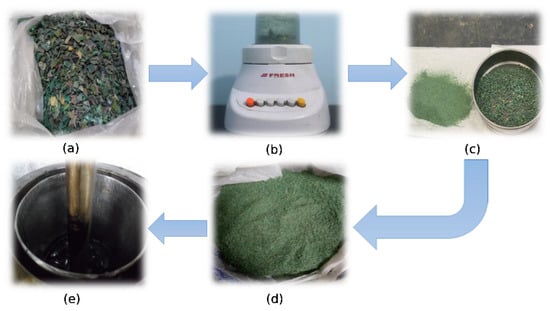
Figure 3.
Modifying VB with fine granular HDPEW (VB+FG-HDPEW). (a) HDPEW out of bottle crates. (b) grinding HDPEW. (c) sieving ground HDPEW on sieve #16. (d) FG-HDPEW passing sieve #16. (e) producing FG-HDPEW modified bitumen.
2.1.3. Aged Bitumen (AB)
RAP materials were obtained from Coastal International Road and were estimated to have a lifespan of more than 15 years. RAP samples were subjected to the extraction and recovery centrifugation technique using a methylene chloride solvent solution based on the ASTM D2172 test method [41]. The ASTM specification was used to carry out this process to obtain AB, and any remaining solvent was eliminated by distillation of the tested sample, as shown in Figure 4. The main characteristics of extracted AB are included in Section 3.
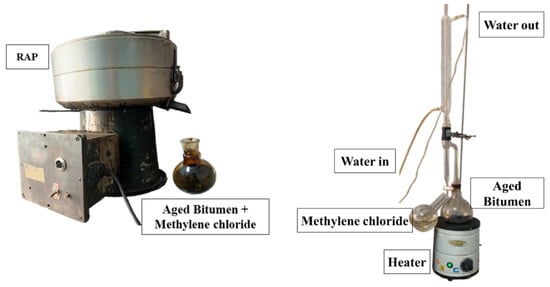
Figure 4.
Recovering aged bitumen out of RAP. (left) Extraction apparatus. (right) Distillation apparatus.
2.1.4. Rejuvenated Aged Bitumen (AB+PO-HDPEW)
The pyrolysis process begins by placing 50 g of HDPEW from bottle crates in a heat-resistant glass crucible, as assessed by Kumar and Singh [42]. The crucible is continuously heated at a rate of 20 °C/min until the temperature reaches 500 °C. At this point, the long chemical chains are cracked, and the pyro-oil starts to drip into a receiver bottle; this continues until the temperature reaches 750 °C. The pyrolysis process occurs in the absence of oxygen, according to [42], as described in Figure 5.
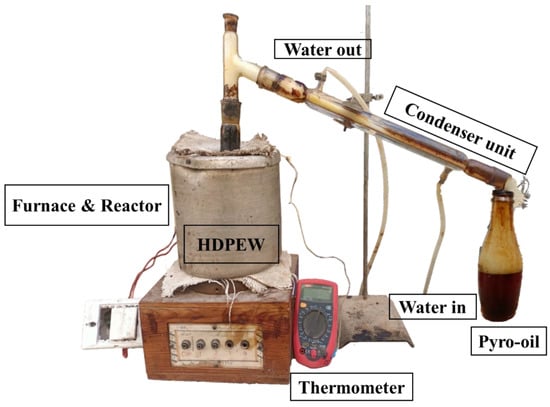
Figure 5.
Thermal pyrolysis process apparatus.
After conducting the extraction and recovery process on the RAP samples and obtaining the AB, the pyro-oil was added in different proportions of 10, 20, and 30% (by total weight of AB) to determine the optimal percentage of the pyro-oil as a rejuvenator for AB locally extracted from an aged pavement to restore its original properties. Then, the blend was mixed for 15 min using a high-shear mixer at an elevated temperature of 150 °C and rotational speed of 5000 rpm. During the last 5 min, the mixing speed was reduced to 3000 rpm, according to Hadole et al. [32]. The production process of the rejuvenated aged bitumen with the pyro-oil (AB+PO-HDPEW) is explained in Figure 6.
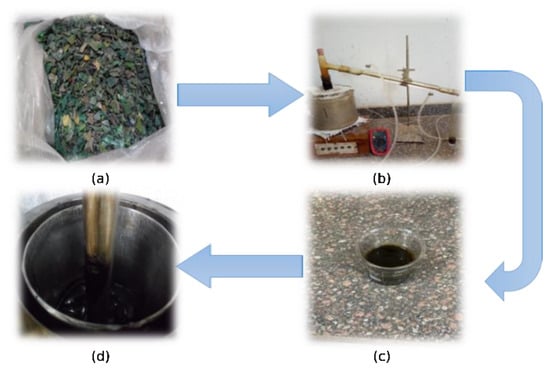
Figure 6.
Rejuvenating AB with pyro-oil (AB+PO-HDPEW). (a) HDPEW out of bottle crates. (b) thermal pyrolysis setup. (c) PO-HDPEW. (d) producing PO-HDPEW modified bitumen.
2.2. Methods
A comprehensive experimental testing matrix was performed on VB, VB+FG-HDPEW, AB, and AB+PO-HDPEW to investigate their physical, chemical, mechanical, and rheological characteristics. Each testing result was based on the average of three replicates to ensure testing accuracy and reduce output variability. The testing program included (1) physical and chemical tests such as scanning electronic microscopy (SEM), energy dispersive X-ray (EDX), and Fourier transform infrared spectroscopy (FTIR); (2) mechanical and rheological bitumen testing such as penetration, softening point, Brookfield rotational viscosity (RV), dynamic shear rheometer (DSR), rolling thin-film oven (RTFO), multiple stress creep and recovery (MSCR), pressure aging vessel (PAV), and linear amplitude sweep (LAS), as previously presented in Figure 2. The specimen type, aging condition, testing purpose, and standard specifications of these experimental tests are summarized in Table 1.

Table 1.
The experimental testing program.
3. Results and Discussion
3.1. Traditional Characterization Tests
3.1.1. Penetration and Softening Point
Penetration at ambient temperature and softening point tests were considered two simple properties for measuring the bitumen consistency and the temperature at which bitumen is softened, respectively [43,44]. The penetration and softening point effect of adding 10, 20, and 30% PO-HDPEW (by total weight of AB) to rejuvenate AB was investigated, as shown in Figure 7a,b. However, the penetration and softening point effect of adding 2, 3, 4, and 5% FG-HDPEW (by total weight of VB) to modify VB according to [25] are shown in Figure 7c,d.
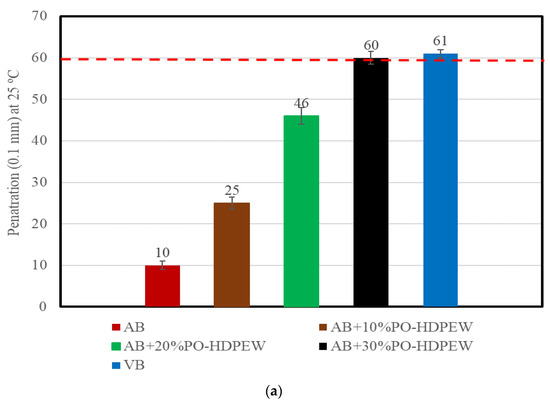
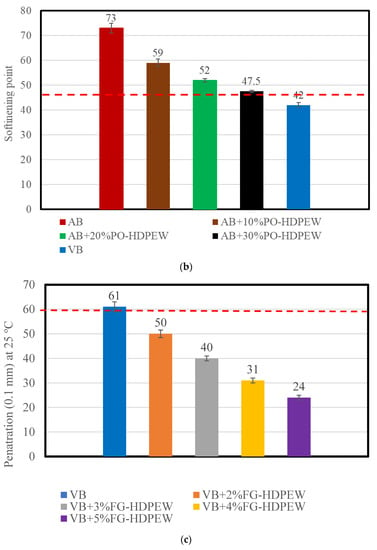
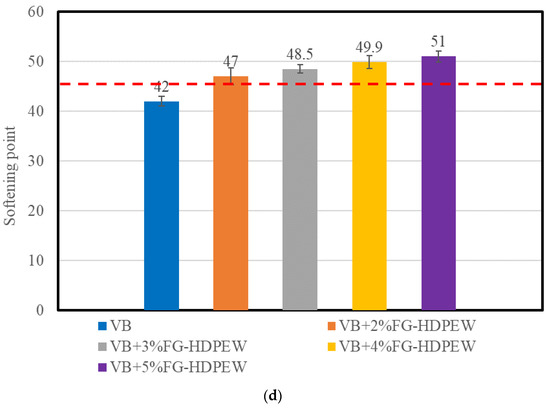
Figure 7.
Results of penetration and softening point tests. (a) Penetration of VB vs. AB and PO-HDPEW-rejuvenated bitumen; (b) softening point of VB vs. AB and PO-HDPEW-rejuvenated bitumen; (c) penetration of VB vs. FG-HDPEW-modified bitumen; (d) softening point of VB vs. FG-HDPEW-modified bitumen.
It was obvious that the penetration value increased linearly with the increase in the PO-HDPEW percentage. Based on the penetration testing, the penetration value of AB was the lowest among the explored sample types, followed by 10%, 20%, and 30% of PO-HDPEW (by total weight of AB), respectively. The 30%PO-HDPEW-rejuvenated bitumen has almost the same penetration as VB, which was graded (Pen 60/70), as shown in Figure 7a. Similarly, the softening point temperature decreased linearly with the increase in PO-HDPEW percentage. Based on the softening point testing with a target temperature of at least 45 °C, the softening point temperature of AB was the highest among the explored samples, followed by 10%, 20%, and 30% of PO-HDPEW (by total weight of AB), respectively. The 30%PO-HDPEW-rejuvenated bitumen had the nearest level of softening point to VB with a value of 42 °C, as shown in Figure 7b. However, it achieved the minimum required SP according to the Egyptian specifications which is 45 °C. Thus, rejuvenating AB with 30% of PO-HDPEW resulted in similar values of penetration and softening point to the pristine values of VB.
Contradictorily, the trend of both penetration and softening point values was reversely followed when the VB was modified with 2, 3, 4, and 5% of FG-HDPEW (by total weight of VB), respectively, in Figure 7c,d. Whereas VB showed the highest penetration and lowest softening point among the explored samples, this was due to a decrease in aromatic content, which has been linked to a reduction in penetrability and a rise in softening point [51,52,53]. Therefore, the results referred that modifying VB with FG-HDPEW has a considerable influence on leading to harder or stiffer bitumen and decreasing aromatic components.
Moreover, the penetration index (PI), which evaluates the temperature susceptibility at the mean in-service temperature, can be determined according to the following equation [51].
where P25 is the penetration value at room temperature of 25 °C, and SP is the softening point, °C.
The PI values for the AB, PO-HDPEW-rejuvenated bitumen, VB, and FG-HDPEW-modified bitumen are included in Table 2. Lower PI values refer to higher susceptibility to temperature. According to the findings, AB was the lowest sensitive bitumen to temperature variations, while VB was the highest sensitive bitumen to temperature variations. The vulnerability of the investigated percentages of PO-HDPEW-rejuvenated bitumen to temperature fluctuations increased when the proportions of PO-HDPEW were raised significantly due to the significant changes in their penetration and softening point values. However, the vulnerability of the investigated percentages of FG-HDPEW-modified bitumen to temperature fluctuations had a non-significant increase when the proportions of FG-HDPEW were slightly raised due to the non-significant changes in their softening point values, which, in turn, affected their PI values.

Table 2.
PI of the investigated bitumen types.
3.1.2. Rotational Viscosity (RV)
By conducting the RV test according to AASHTO T 316 [45], the viscosity of the AB, VB, rejuvenated PO-HDPEW bitumen, and modified FG-HDPEW bitumen was determined at 135, 150, and 165 °C. Figure 8 represents the viscosity measurements in cP at the investigated temperatures in °C for each bitumen type.
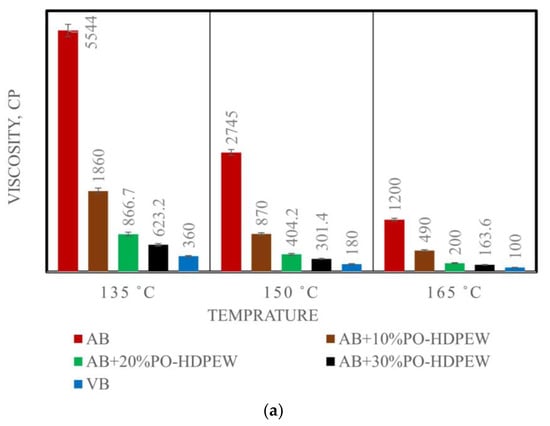
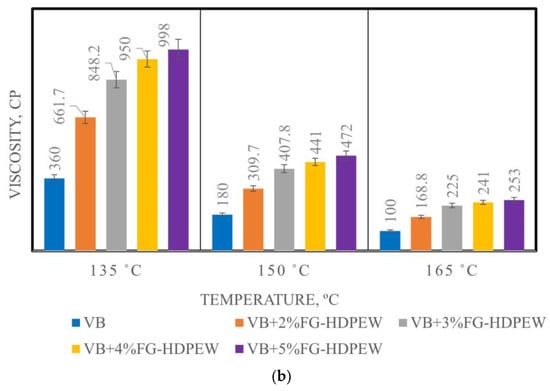
Figure 8.
Results of rotational viscosity test. (a) Rotational viscosity of VB vs. AB and PO-HDPEW-rejuvenated bitumen; (b) rotational viscosity of VB vs. FG-HDPEW-modified bitumen.
It was noticed that the AB had the highest absolute viscosity, while the VB had the lowest absolute viscosity among the explored types of bitumen. The viscosity decreased in a logarithmic manner with the increase in PO-HDPEW percentage, as shown in Figure 8a, while it increased in a logarithmic manner with the increase in the FG-HDPEW percentage in Figure 8b. The effect of increasing the percentage of FG-HDPEW from 4% to 5% was not overly significant on the absolute viscosity. In addition, the examined types of bitumen met the Superpave criteria of not exceeding 3000 cP at 135 °C according to AASHTO M 320 [54] except the AB.
3.2. Morphological and Chemical Tests
3.2.1. Scanning Electron Microscopy (SEM)/Energy Dispersive X-ray Spectroscopy (EDX)
SEM/EDX is a valuable technique for determining the surface profile and physical properties in addition to characterizing the composition and distribution of surface contaminants of bitumen. For SEM and EDX analyses, a JEOL JSM 65101v microscope and Oxford X-Max 20 equipment were used, respectively.
Figure 9 shows the SEM images, while Table 3 presents the EDX analysis data of AB, VB, PO-HDPEW-rejuvenated bitumen, and FG-HDPEW-modified bitumen. The examined types of bitumen are depicted in Figure 9 at a scale of ×2000. All samples were suitable for the voltage intensity of 30 kilovolts at this scale and were in their original condition (no aging condition) except for the AB.
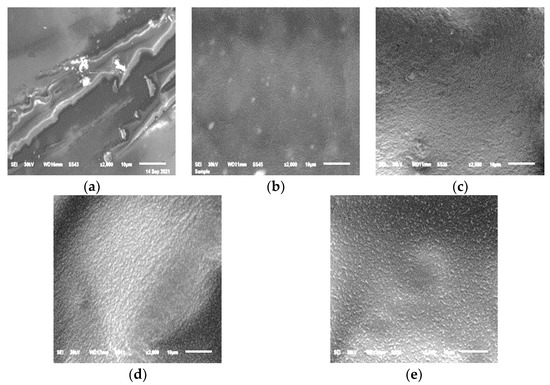
Figure 9.
SEM images of AB, VB, PO-HDPEW-rejuvenated bitumen, and FG-HDPEW-modified bitumen at (×2000). (a) AB; (b) AB+30%PO-HDPEW; (c) VB; (d) VB+3%FG-HDPEW; (e) VB+5%FG-HDPEW.

Table 3.
EDX outcomes of AB, VB, PO-HDPEW-rejuvenated bitumen, and FG-HDPEW-modified bitumen.
As shown in Figure 9a,b, adding 30% of PO-HDPEW to the AB improved the morphological properties; the disturbances faded, producing a softer surface and supporting the application of PO-HDPEW to rejuvenate the AB. According to Table 3, the AB had predominant elements such as C, O, and S, in addition to small proportions of Al, Si, Ca, and Fe. During the pyrolysis of HDPE, the main products typically include hydrocarbons, such as alkanes, alkenes, and aromatic compounds. Nitrogen-containing compounds are not inherent to HDPE itself and are less likely to be formed during the pyrolysis process unless nitrogen-containing additives or impurities are present in the HDPE material. Therefore, under normal circumstances, the oil obtained from the pyrolysis of HDPE would not contain significant amounts of nitrogen. However, it is important to note that the specific conditions and additives used in the pyrolysis process can influence the composition of the resulting products. As long as the HDPEW used in this study was out of bottle crates, PO-HDPEW was composed of the following elements: C, N, O, and Cu. Adding 30% of PO-HDPEW to the AB led to the survival of some of the main elements, such as C and N. Nevertheless, other elements’ percentages increased, such as O, Ca, and Cu. Finally, the 30% PO-HDPEW-modified AB showed the disappearance of some elements such as Al, Si, S, and Fe.
On the other hand, FG-HDPEW was used as a modifier to VB, with two different ratios: 3% and 5%. The SEM technician had to raise the voltage intensity to 30 kV to be able to record the bumpy side of the FG-HDPEW-modified bitumen (VB+3%FG-HDPEW and VB+5% FG-HDPEW). Therefore, Figure 9c–e demonstrates that the microstructure of the VB tends to be wavy in particular directions and helps to improve the reaction with the FG-HDPEW modifier. According to Table 3, the predominant mineral phases of the VB were C, O, and S. Adding 3% of FG-HDPEW to VB led to the disappearance of O and S elements and the appearance of other elements such as Al, Si, and Ca. However, increasing the percentage of FG-HDPEW to 5% represented the S element again in addition to Si and Ca elements.
3.2.2. Fourier Transform Infrared Spectroscopy (FTIR)
Vibrational spectroscopy using FTIR analysis is a method for both qualitative and quantitative determination of molecular structure in a variety of substances, including organic, polymeric, and sometimes inorganic compounds [55]. By examining the FTIR spectrum using the Nicolet iS10 device, chemical bonds can be identified to distinguish the presence of polymers in modified bitumen based on their respective wavelengths, as well as to elucidate the mixing mechanism between polymers and VB. Table 4 represents the main functional groups and provides their corresponding peak locations. In this study, FTIR chemical analysis was conducted by coating a thin potassium bromide disc (KBr) with a bitumen binder solution (0.05 g bitumen/50 mL dichloromethane).

Table 4.
Functional groups based on FTIR wavelength results.
Figure 10 shows the FTIR spectrum of the VB, AB, PO-HDPEW-rejuvenated bitumen, and FG-HDPEW-modified bitumen. Without shifting in position, AB displayed the primary characteristic vibration bands, as shown in Table 4, based on their predefined wavelength ranges. Due to the high concentration of vibration groups of 30%PO-HDPEW-rejuvenated bitumen, all bands were intensified when added to AB. The OH absorption band vanished at a wavelength of 3438 cm−1 in the FTIR spectrum of AB, and two CH alkane-related absorption bands were visible at wavelengths 2921 and 2853 cm−1. The existence of the carbonyl group (C=O) was further indicated by a strong absorption band at a wavelength of 1696 cm−1, and the presence of the C=C function group in AB was also supported by an absorption peak with one stretching at a wavelength of 1513 cm−1; however, the band at a wavelength of 725 cm−1 is always associated with bending vibrations of the C–H bond in long alkyl chains. Additionally, the existence of the frequencies at a wavelength of 1457 cm−1 was for bending vibrations of the C-H bond in the CH2 and CH3 groups. As shown in Figure 10a, the OH stretching absorption band was present at a wavelength of 3378 cm−1; however, the high-intensity band at a wavelength of 1375 cm−1 is always attributed to bending vibrations of the C-H bond in the CH3 and CH2 groups, and it existed in the 30%PO-HDPEW-rejuvenated bitumen as seen in the FTIR spectra due to the PO-HDPEW rejuvenator. Additionally, the 30%PO-HDPEW-rejuvenated bitumen, as shown in Figure 10a, exhibited two enlarged absorption bands at wavelengths of 2921 and 2853 cm−1 because the rejuvenator contains CH aliphatic. The existence of the C=C function group was confirmed by one absorption peak having a stretching frequency peak at a wavelength of 1520 cm−1 and a C–H bending frequency peak at 725 cm−1. The occurrence of stretching frequency for the rejuvenated bitumen at a wavelength of 1455 cm−1 relates to aromatic rings, as previously illustrated in Figure 10a. The rejuvenator’s infrared spectrum exhibited an absorption peak caused by C-O around a wavelength of 1037 cm−1. In conclusion, the addition of 30%PO-HDPEW to AB caused the development of both the OH group at 3378 cm−1 and C-H bending vibrations at 1375 cm−1, which vanished in AB. Additionally, the conjugated system with the C=O function was enhanced, which resulted in a minor drop in the stretching frequency (C=C). This modest reduction in C=C bonds following the addition of 30%PO-HDPEW to AB may result in a reduction in the number of asphaltenes. However, the appearance of hydroxide (-OH) was increased in the rejuvenated bitumen by the rejuvenator, indicating an increase in the maltenes concentration. As a result, rather than increasing as it did in AB, the asphaltenes to maltenes ratio was reduced in the rejuvenated bitumen; however, it did not return to the virgin sample’s original levels. Finally, there was an increase in the intensity of the signals so that they approached the VB, as shown in Figure 10a.
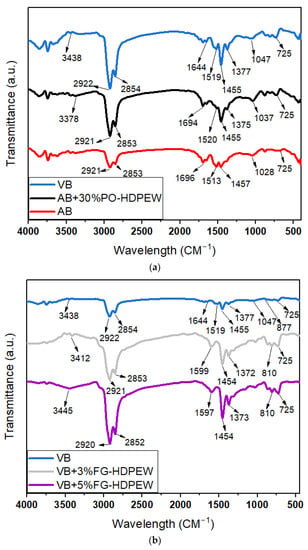
Figure 10.
FTIR spectrum analysis. (a) FTIR spectrum of VB vs. AB and PO-HDPEW-rejuvenated bitumen; (b) FTIR spectrum of VB vs. FG-HDPEW-modified bitumen.
On the other hand, the FTIR spectrum of VB showed bands at 3438, 2922, 2854, 1644, 1455, 1377, and 1047 cm−1, which are characteristic of OH stretching, CH alkane stretching, C=O carbonyl, C-H bending, C-H bending, and C-O function groups, respectively, as shown in Table 3. The FTIR spectrum of FG-HDPEW-modified bitumen showed all bands at the same positions, except two bands at wavelengths of 1644 cm−1 (C=O) and 1047 cm−1 (C-O); their disappearance was due to the addition of FG-HDPEW to VB. In addition, the peak at 1519 cm−1 for VB underwent a shift to 1599 and 1597 cm−1 for VB+3%FG-HDPW and VB+5%FG-HDPW, respectively. Additionally, the peak at 877 cm−1 for VB underwent a shift to 810 cm−1 in both VB+3%FG-HDPW and VB+5%FG-HDPW, as shown in Figure 10b and Table 4. In conclusion, when the FG-HDPEW is added to VB, the percentage of asphaltene increases, and the percentage of maltene decreases in FG-HDPEW-modified bitumen.
3.3. Advanced Rheomechanical Tests
3.3.1. Dynamic Shear Rheometer (DSR)
In order to study the elastic and viscous behaviors of the investigated bitumen types, complex shear modulus (G*) and phase angle (δ) at high and intermediate temperatures were determined using a DSR device (Anton Paar SmartPave 102e). This classification was performed according to AASHTO T315 [46] at no aging, after rolling thin film oven (RTFO)/short-term aging, and after pressure aging vessel (PAV)/long-term aging conditions. Three replicates were tested from each bitumen type, and the results were analyzed based on the average of their measurements. The DSR testing parameters were used to evaluate the resistance of the bitumen blends to rutting and fatigue cracking and to characterize the shear stress resistance of RTFO-aged specimens at high-temperature utilization and PAV-aged specimens at intermediate temperatures. The test was conducted according to AASHTO T315 [46].
Rutting Parameter (G*/sin δ)
The rutting parameter (G*/sin δ), which was recommended by the AASHTO M320 Superpave bitumen specification [54], was determined and is presented in Figure 11a,b. This parameter was used to characterize the ability of the investigated binders to resist permanent deformation (specifications recommend G*/sin δ ≥ 1 KPa for bitumen at no aging condition and ≥2.2 KPa for bitumen after RTFO aging condition). Figure 12a illustrates that the rutting parameter for AB was shifted at elevated temperatures due to the long service life of the pavement (around 15 years). By adding 30%PO-HDPEW (optimal ratio) to AB at no aging condition, an improvement in the G*/sin δ values was evident and became almost very close to the ideal values for the G*/sin δ of VB. After the short-term aging condition, Figure 11b reveals the change in the G*/sin δ value for the RTFO-sample of 30%PO-HDPEW-rejuvenated bitumen. There was a significant transformation for G*/sin δ values of rejuvenated bitumen after the introduction of short-term aging and the volatilization of the pyro-oil components. The DSR test was carried out on the RTFO sample, and the test results returned to the same or close to the results of AB; this is due to the instability of the PO-HDPEW rejuvenator after short-term aging conditions. Once the blended bitumen with pyro-oil was subjected to aging conditions, the rate of aging increased significantly, which negatively impacted the rejuvenated bitumen. This indicates that PO-HDPEW needs more deep research in order to be successfully used in flexible pavement applications.

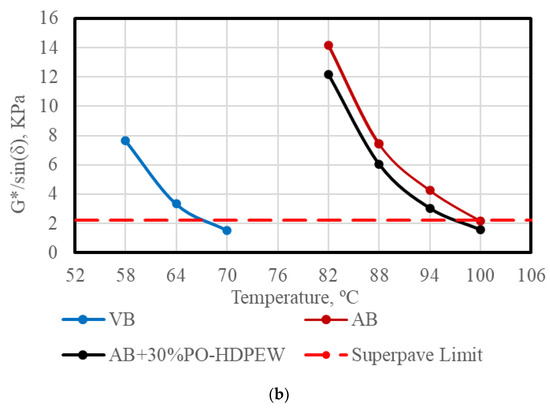
Figure 11.
DSR testing results of VB, AB, and PO-HDPEW-rejuvenated bitumen. (a) Rutting parameter of VB vs. AB and PO-HDPEW-rejuvenated bitumen under no aging condition; (b) rutting parameter of VB vs. AB and PO-HDPEW-rejuvenated bitumen after RTFO aging condition.
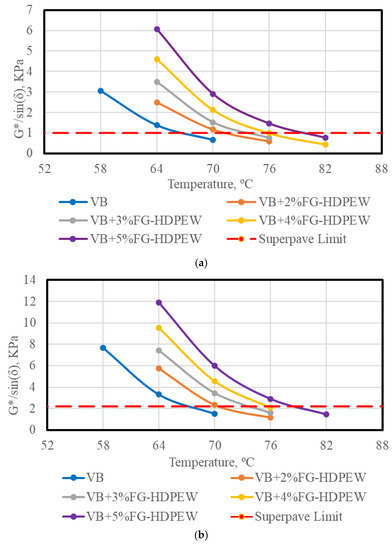
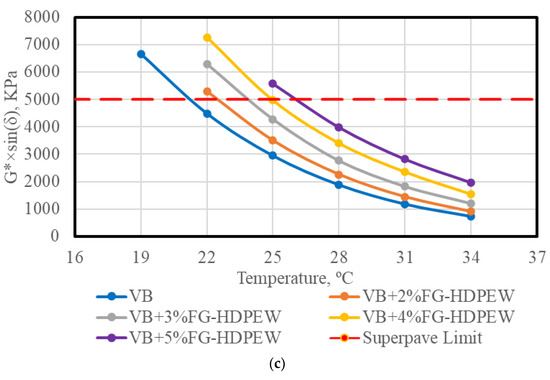
Figure 12.
DSR testing results of VB and FG-HDPEW-modified bitumen. (a) Rutting parameter of VB vs. FG-HDPEW-modified bitumen under no aging condition; (b) rutting parameter of VB vs. FG-HDPEW-modified bitumen after RTFO aging condition; (c) fatigue parameter of VB vs. FG-HDPEW-modified bitumen after PAV aging condition.
On the other hand, FG-HDPEW-modified bitumen was investigated under no aging and RTFO-aging conditions and compared to VB (see Figure 12a,b). Higher rutting parameter values indicated that FG-HDPEW-modified bitumen had greater resistance to permanent deformation compared to VB, and thus its performance at elevated temperatures was improved, as shown in Figure 12a,b. Based on DSR testing, Figure 12a,b shows the tested failure temperatures under no aging and RTFO-aging conditions. According to this study, the FG-HDPEW modifier enables modified bitumen to achieve Performance Grade PG 70 and PG 76, which are required for the northern and southern Egyptian regions, respectively [52]. Therefore, FG-HDPEW-modified bitumen is suitable to resist the hot summer climate in Egypt.
Fatigue Parameter (G* × sin δ)
By comparing the fatigue parameter (G* × sin δ), the DSR device was also utilized to determine the long-aged bitumen’s resistance to fatigue crackability at intermediate temperatures (specifications recommend G* × sin δ ≤ 5000 KPa for bitumen under PAV aging condition). This is ascertained in Figure 12c. As long as the bitumen meets the maximum Superpave criterion of 5000 kPa or less at certain intermediate temperatures, this means better fatigue resistance. Therefore, as shown in Figure 12c, adding the FG-HDPEW modifier to VB was valid and suitable for the local climate to resist fatigue cracking at intermediate climate temperatures.
3.3.2. Multiple Stress Creep and Recovery (MSCR)
The MSCR test was employed to investigate the elastic behavior of the examined bitumen types, particularly in cases where the response exhibited nonlinearity and was highly dependent on the magnitude of the applied pressure during the test. This type of testing was especially relevant for the modified types of bitumen [56,57]. The MSCR test was carried out according to AASHTO T350 [48] on RTFO-aged samples. The testing procedure involved subjecting the tested samples to a couple of different stress states (0.1 and 3.2 kPa) at the high-performance grade temperature and allowing them to recover after stress level application during each cycle. The testing process included 10 cycles of creep/recovery at each stress level with a one-second creep load followed by a nine-second recovery period in each cycle.
Table 5 presents the results of MSCR testing on the investigated bitumen types based on an average of three replicates. The bitumen’s performance was evaluated based on the nonrecoverable creep compliance (Jnr), which reflects its ability to resist permanent deformation at high temperatures [58]. Table 5 displays the results of the MSCR test conducted on AB, VB, and PO-HDPEW-rejuvenated bitumen and the bitumen modified with different dosages of FG-HDPEW. The findings indicated that adding 2% of FG-HDPEW was able to increase the bitumen to one high PG grade; however, to achieve two successive high PG grades, VB had to be modified with no less than 5% of FG-HDPEW. In addition, the suitable traffic levels based on MSCR results for different types of bitumen are included in the table (“S” for standard traffic and “H” for heavy traffic).

Table 5.
MSCR testing results on the rejuvenated and modified bitumen.
The modified bitumen’s elastic response and stress dependence are assessed in Figure 13. This was examined by plotting the percentage recovery at 3.2 kPa, against the 3.2 kPa nonrecoverable creep compliance. Based on Figure 13, FG-HDPEW-modified bitumen indicated non-elastomeric behavior at high temperatures as the points fell way below the curve. As expected, there was non-significant recovery observed for VB, AB, and PO-HDPEW-rejuvenated bitumen matching the rutting parameter results.
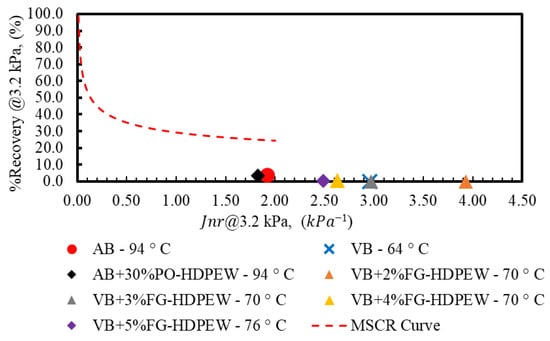
Figure 13.
Percentage recovery vs. nonrecoverable creep compliance at 3.2 kPa stress level.
3.3.3. Linear Amplitude Sweep (LAS)
In accordance with AASHTO T 391-20 [50], the LAS test was conducted to investigate the fatigue behavior of VB and FG-HDPEW-modified bitumen. Two procedures were conducted to determine the fatigue life criterion (Nf) and the undamaged material parameter (α) using the viscoelastic continuum damage theory. The first procedure involved applying constant amplitude oscillatory shear loading to a variety of loading frequencies using a frequency sweep testing technique. The second procedure used amplitude sweep testing and employed oscillatory shear operating in strain-control mode at a frequency of 10 Hz. The testing results were used to determine Nf and α according to Equations (2) and (3) [50].
where Nf is the bitumen fatigue performance parameter; α is the undamaged bitumen parameter; γmax is the maximum expected bitumen strain for a given pavement structure, percent. A35; B are the regression parameters that depend on bitumen characteristics; m is the slope of the frequency–shear modulus graph.
For a given stress level, lower Nf values indicated that the bitumen was increasingly prone to fatigue cracking. The fatigue properties of the tested bitumen types are exhibited in Table 6 based on the average of the measurements of three PAV-aged replicates that were examined at intermediate temperature levels. Based on the PG of the examined bitumen types, the intermediate temperatures of VB, VB+2%FG-HDPEW, VB+3%FG-HDPEW, VB+4%FG-HDPEW, and VB+5%FG-HDPEW were 22, 25, 25, 25, and 28 °C, respectively, as shown in Table 6. In addition, the fatigue lives for the tested bitumen types of 2.5% and 5.0% strain illustrated a significant increase in Nf (2.5) and Nf (5.0) with the increase in the intermediate testing temperature, as shown in Table 6. In addition, it was evident that the Nf (2.5) values were remarkably higher than the Nf (5.0) values, which led to a decrease in crack resistance. When the intermediate testing temperature increased, the adhesive material was found to be more flexible and less stiff, indicating better resistance to fatigue. Furthermore, it was more obvious within the same performance grade level due to the 2, 3, and 4% addition of FG-HDPEW to VB that increasing the percentage of the modifier enhanced the resistance of the FG-HDPEW-modified bitumen to fatigue cracking. Summarizing LAS testing results, 3% of FG-HDPEW to achieve PG70 and 5% of FG-HDPEW to achieve PG76 were able to enhance the bitumen cracking resistance at intermediate temperature levels compared to VB performance.

Table 6.
LAS testing results of VB vs. FG-HDPEW-modified bitumen.
4. Conclusions
In conclusion, the rejuvenation of aged bitumen is a crucial area of research as it helps to restore the maltenes content that is reduced by aging. Additionally, modifying virgin bitumen is essential to enhance its rutting and cracking resistance properties. This approach offered an opportunity to recycle HDPE plastic waste and contribute to environmental protection while also being more economical, considering the wide variety of applications that fall within the properties of other polymers. The pyro-oil and fine-ground granules of HDPEW sourced out of bottle crates were explored as a rejuvenator and modifier to bitumen, respectively.
Based on the morphological and chemical testing results, it can be concluded that the addition of PO-HDPEW to AB improved its physical properties, resulting in a softer surface. The formation of an OH- bond and C-H bending vibrations at wavelengths 3378 and 1375 cm−1, respectively, indicated the interaction between PO-HDPEW and AB. FG-HDPEW-modified bitumen with 3% and 5% ratios showed an improved microstructure, which helps to enhance the reaction with the modifier. Additionally, the breakup of C=O and C-O bonds at wavelengths of 1644 and 1047 cm−1, respectively, also indicated the interaction between FG-HDPEW and VB. The FTIR analysis of the AB, VB, PO-HDPEW-rejuvenated bitumen, and FG-HDPEW-modified bitumen revealed the characteristic vibration bands of each type, indicating the presence of different functional groups. The addition of PO-HDPEW to AB and FG-HDPEW to VB intensified all bands. FTIR results demonstrated that the addition of PO-HDPEW to AB and FG-HDPEW modification to VB can enhance the physical and chemical properties of bitumen, which can improve its performance in pavement construction and maintenance.
Based on the mechanical and rheological testing results, the PI revealed that AB was the least sensitive to temperature variations, while VB was the most sensitive. Increasing the percentage of PO-HDPEW and FG-HDPEW made the bitumen more vulnerable to temperature variations. The RV results exhibited that AB had the highest absolute viscosity while VB had the lowest. The viscosity decreased logarithmically with the increase in PO-HDPEW percentage and increased logarithmically with the increase in FG-HDPEW percentage. The DSR results showed that adding 2% of FG-HDPEW was able to increase the high-temperature PG of bitumen by one grade (PG70), while adding 5% of FG-HDPEW was required to pump the high-temperature PG by two grades (PG76). Incorporating HDPEW into bitumen has shown improved resistance to permanent deformation and fatigue cracks due to the enhanced stability, flexibility, and high molecular weight of the modified binders. The results of the MSCR test revealed that VB and rejuvenated bitumen had no significant recovery, indicating low elasticity, while FG-HDPEW-modified bitumen displayed non-elastomeric behavior at high temperatures. The LAS test showed that increasing the intermediate testing temperature improved the fatigue performance of the bitumen.
The study recommends further research on the aging performance of PO-HDPEW-rejuvenated bitumen and the optimization of the dosage of the modifier for better performance. Overall, the findings of this study contribute to the knowledge of the use of waste polymers as rejuvenators and modifiers to bitumen and provide insights into the properties and behavior of HDPEW-rejuvenated and -modified bitumen.
Author Contributions
S.A.A.-T.: Methodology, Investigation, Analysis, Testing, Resources, Writing—original draft. A.M.A.: Conceptualization, Methodology, Supervision, Validation, Visualization, Writing—review and editing. A.R.G.: Conceptualization, Methodology, Supervision, Writing—review and editing. S.M.E.-B.: Conceptualization, Methodology, Supervision, Writing—review and editing. All authors have read and agreed to the published version of the manuscript.
Funding
The authors received no financial support for the research, authorship, and/or publication of this article.
Institutional Review Board Statement
Not applicable.
Informed Consent Statement
Not applicable.
Data Availability Statement
Data is available upon request from the corresponding author.
Conflicts of Interest
The authors declare no conflict of interest.
References
- Abdelfattah, I. Laboratory Evaluation of Asphalt Mixtures Modified with Nanomaterials. Master’s Thesis, Mansoura University, Mansoura, Egypt, 2016. [Google Scholar]
- Sörensen, A.; Wichert, B. Asphalt and bitumen. Ullmann’s Encycl. Ind. Chem. 2000, 42, 2374–2380. [Google Scholar]
- Colbert, B.; You, Z. The Properties of Asphalt Binder Blended with Variable Quantities of Recycled Asphalt Using Short Term and Long-Term Aging Simulations. Constr. Build. Mater. 2012, 26, 552–557. [Google Scholar] [CrossRef]
- Copeland, A. Reclaimed Asphalt Pavement in Asphalt Mixtures: State of the Practice; FHWA Publication No. FHWA-HRT-11; FHWA, U.S. Department of Transportation Federal Highway Administration: Washington, DC, USA, 2011; Volume 21.
- Ameri, M.; Mansourkhaki, A.; Daryaee, D. Evaluation of Fatigue Behavior of High Reclaimed Asphalt Binder Mixes Modified with Rejuvenator and Softer Bitumen. Constr. Build. Mater. 2018, 191, 702–712. [Google Scholar] [CrossRef]
- Yu, H.; Zhu, Z.; Zhang, Z.; Yu, J.; Oeser, M.; Wang, D. Recycling Waste Packaging Tape into Bituminous Mixtures towards Enhanced Mechanical Properties and Environmental Benefits. J. Clean. Prod. 2019, 229, 22–31. [Google Scholar] [CrossRef]
- García, Á.; Schlangen, E.; van de Ven, M.; Sierra-Beltrán, G. Preparation of Capsules Containing Rejuvenators for Their Use in Asphalt Concrete. J. Hazard. Mater. 2010, 184, 603–611. [Google Scholar] [CrossRef] [PubMed]
- El-Shorbagy, A.M.; El-Badawy, S.M.; Gabr, A.R. Investigation of Waste Oils as Rejuvenators of Aged Bitumen for Sustainable Pavement. Constr. Build. Mater. 2019, 220, 228–237. [Google Scholar] [CrossRef]
- Jamshidi, M. Systems of Systems Engineering: Principles and Applications; CRC Press: Boca Raton, FL, USA, 2017. [Google Scholar]
- Pradhan, S.K.; Sahoo, U.C. Use of Mahua Oil for Rejuvenation of the Aged Binder through Laboratory Investigations. Int. J. Transp. Sci. Technol. 2022, 11, 32–45. [Google Scholar] [CrossRef]
- Hınıslıoğlu, S.; Ağar, E. Use of Waste High Density Polyethylene as Bitumen Modifier in Asphalt Concrete Mix. Mater. Lett. 2004, 58, 267–271. [Google Scholar] [CrossRef]
- Kanitpong, K.; Cho, D.-W.; Bahia, H. Effect of Additives on Performance of Asphalt Mixtures. Proc. Inst. Civ. Eng. Mater. 2006, 159, 103–110. [Google Scholar] [CrossRef]
- Espinoza-Luque, A.F.; Al-Qadi, I.L.; Ozer, H. Optimizing Rejuvenator Content in Asphalt Concrete to Enhance Its Durability. Constr. Build. Mater. 2018, 179, 642–648. [Google Scholar] [CrossRef]
- Hussein, Z.H.; Yaacob, H.; Idham, M.K.; Hassan, N.A.; Choy, L.J.; Jaya, R.P. Restoration of Aged Bitumen Properties Using Maltenes. IOP Conf. Ser. Mater. Sci. Eng. 2020, 713, 012014. [Google Scholar] [CrossRef]
- Al-Saffar, Z.H.; Yaacob, H.; Mohd Satar, M.K.I.; Mohd Usak, S.N.; Jaya, R.P.; Hassan, N.A.; Radeef, H.R.; Warid, M.N.M. Evaluating the Performance of Reclaimed Asphalt Pavement Incorporating PelletRAP as a Rejuvenator. IOP Conf. Ser. Earth Environ. Sci. 2021, 682, 012068. [Google Scholar] [CrossRef]
- Huang, W.; Guo, Y.; Zheng, Y.; Ding, Q.; Sun, C.; Yu, J.; Zhu, M.; Yu, H. Chemical and Rheological Characteristics of Rejuvenated Bitumen with Typical Rejuvenators. Constr. Build. Mater. 2021, 273, 121525. [Google Scholar] [CrossRef]
- Costa, L.M.B.; Silva, H.; Oliveira, J.R.M.; Fernandes, S.R.M. Incorporation of Waste Plastic in Asphalt Binders to Improve Their Performance in the Pavement. Int. J. Pavement Res. Technol. 2013, 6, 457–464. [Google Scholar]
- Daryaee, D.; Ameri, M.; Mansourkhaki, A. Utilizing of Waste Polymer Modified Bitumen in Combination with Rejuvenator in High Reclaimed Asphalt Pavement Mixtures. Constr. Build. Mater. 2020, 235, 117516. [Google Scholar] [CrossRef]
- Mogawer, W.S.; Austerman, A.J.; Kluttz, R.; Puchalski, S. Using Polymer Modification and Rejuvenators to Improve the Performance of High Reclaimed Asphalt Pavement Mixtures. Transp. Res. Rec. 2016, 2575, 10–18. [Google Scholar] [CrossRef]
- Al-Salem, S.M.; Yang, Y.; Wang, J.; Leeke, G.A. Pyro-Oil and Wax Recovery from Reclaimed Plastic Waste in a Continuous Auger Pyrolysis Reactor. Energies 2020, 13, 2040. [Google Scholar] [CrossRef]
- Al-Salem, S.M.; Lettieri, P.; Baeyens, J. The Valorization of Plastic Solid Waste (PSW) by Primary to Quaternary Routes: From Re-Use to Energy and Chemicals. Prog. Energy Combust. Sci. 2010, 36, 103–129. [Google Scholar] [CrossRef]
- Al-Salem, S.M.; Antelava, A.; Constantinou, A.; Manos, G.; Dutta, A. A Review on Thermal and Catalytic Pyrolysis of Plastic Solid Waste (PSW). J. Environ. Manag. 2017, 197, 177–198. [Google Scholar] [CrossRef] [PubMed]
- Zhao, Z.; Xiao, F.; Amirkhanian, S. Recent Applications of Waste Solid Materials in Pavement Engineering. Waste Manag. 2020, 108, 78–105. [Google Scholar] [CrossRef] [PubMed]
- Radeef, H.R.; Abdul Hassan, N.; Abidin, A.R.Z.; Mahmud, M.Z.H.; Yusoffa, N.I.M.; Idham Mohd Satar, M.K.; Warid, M.N.M. Enhanced Dry Process Method for Modified Asphalt Containing Plastic Waste. Front. Mater. 2021, 8, 700231. [Google Scholar] [CrossRef]
- Brasileiro, L.; Moreno-Navarro, F.; Tauste-Martínez, R.; Matos, J.; Rubio-Gámez, M. del C. Reclaimed Polymers as Asphalt Binder Modifiers for More Sustainable Roads: A Review. Sustainability 2019, 11, 646. [Google Scholar] [CrossRef]
- Hayat, U.; Rahim, A.; Khan, A.H.; Ur Rehman, Z. Use of Plastic Wastes and Reclaimed Asphalt for Sustainable Development. Balt. J. Road Bridge Eng. 2020, 15, 182–196. [Google Scholar] [CrossRef]
- Nanda, S.; Berruti, F. Thermochemical Conversion of Plastic Waste to Fuels: A Review. Environ. Chem. Lett. 2021, 19, 123–148. [Google Scholar] [CrossRef]
- Soni, V.K.; Singh, G.; Vijayan, B.K.; Chopra, A.; Kapur, G.S.; Ramakumar, S.S. V Thermochemical Recycling of Waste Plastics by Pyrolysis: A Review. Energy Fuels 2021, 35, 12763–12808. [Google Scholar] [CrossRef]
- Aguado, J.; Serrano, D.P.; Escola, J.M. Fuels from Waste Plastics by Thermal and Catalytic Processes: A Review. Ind. Eng. Chem. Res. 2008, 47, 7982–7992. [Google Scholar] [CrossRef]
- Butler, E.; Devlin, G.; Meier, D.; McDonnell, K. A Review of Recent Laboratory Research and Commercial Developments in Fast Pyrolysis and Upgrading. Renew. Sustain. Energy Rev. 2011, 15, 4171–4186. [Google Scholar] [CrossRef]
- Hussein, Z.; Shakor, Z.; Alzuhairi, M.; Al-Sheikh, F. Thermal and catalytic cracking of plastic waste: A review. Int. J. Environ. Anal. Chem. 2021, 1–18. [Google Scholar] [CrossRef]
- Hadole, H.P.; Suryawanshi, S.D.; Khapne, V.A.; Ranadive, M.S. Moisture Damage Resistance of Short-Term Aged Pyro-Oil–Modified Bitumen Using Rolling Thin Film Oven by Surface Free Energy Approach. J. Mater. Civ. Eng. 2021, 33, 4021268. [Google Scholar] [CrossRef]
- Doğan, M. Effect of Polymer Additives on the Physical Properties of Bitumen Based Composites. Master’s Thesis, Middle East Technical University, Ankara, Turkey, 2006. [Google Scholar]
- Gahleitner, M.; Paulik, C. Polypropylene. In Ullmann’s Encyclopedia of Industrial Chemistry; Wiley: Hoboken, NJ, USA, 2014. [Google Scholar]
- Zhou, X.; Zhao, G.; Miljković, M.; Tighe, S.; Chen, M.; Wu, S. Crystallization Kinetics and Morphology of Biochar Modified Bio-Asphalt Binder. J. Clean. Prod. 2022, 349, 131495. [Google Scholar] [CrossRef]
- Plastics Europe. Plastics Europe: Enabling a Sustainable Future. Available online: https://plasticseurope.org/ (accessed on 4 April 2023).
- American Chemistry Council. Available online: https://www.americanchemistry.com/chemistry-in-america/chemistry-in-everyday-products/plastics (accessed on 4 April 2023).
- Wikipedia. Available online: https://en.wikipedia.org/wiki/High-density_polyethylene (accessed on 7 April 2023).
- Attaelmanan, M.; Feng, C.P.; Ai, A.H. Laboratory Evaluation of HMA with High Density Polyethylene as a Modifier. Constr. Build. Mater. 2011, 25, 2764–2770. [Google Scholar] [CrossRef]
- Dalhat, M.A.; Al-Abdul Wahhab, H.I. Performance of Recycled Plastic Waste Modified Asphalt Binder in Saudi Arabia. Int. J. Pavement Eng. 2017, 18, 349–357. [Google Scholar] [CrossRef]
- ASTM D2172–05; Standard Test Methods for Quantitative Extraction of Bitumen from Bituminous Paving Mixtures. ASTM: West Conshohocken, PA, USA, 2005.
- Kumar, S.; Singh, R.K. Recovery of Hydrocarbon Liquid from Waste High Density Polyethylene by Thermal Pyrolysis. Braz. J. Chem. Eng. 2011, 28, 659–667. [Google Scholar] [CrossRef]
- ASTM D5/D5M-20; Standard Test Method for Penetration of Bituminous Materials. ASTM: West Conshohocken, PA, USA, 2020.
- ASTM D36/D36M-14; Standard Test Method for Softening Point of Bitumen (Ring-and-Ball Apparatus). ASTM: West Conshohocken, PA, USA, 2014.
- AASHTO T 316–19; Viscosity Determination of Bitumen Binder Using Rotational Viscometer. AASHTO: Washington, DC, USA, 2019.
- AASHTO T 315–20; Standard Test Method for Determining the Rheological Properties of Bitumen Binder Using a Dynamic Shear Rheometer (DSR). AASHTO: Washington, DC, USA, 2020.
- AASHTO T 240–21; Standard Method of Test for Effect of Heat and Air on a Moving Film of Bitumen Binder (Rolling Thin-Film Oven Test). AASHTO: Washington, DC, USA, 2021.
- AASHTO T 350–19; Multiple Stress Creep Recovery (MSCR) Test of Bitumen Binder Using a Dynamic Shear Rheometer (DSR). AASHTO: Washington, DC, USA, 2019.
- AASHTO R 28–22; Standard Practice for Accelerated Aging of Bitumen Binder Using a Pressurized Aging Vessel (PAV). AASHTO: Washington, DC, USA, 2022.
- AASHTO T 391-20; Estimating Fatigue Resistance of Bitumen Binder Using the Linear Amplitude Sweep. AASHTO: Washington, DC, USA, 2020.
- Read, J.; Whiteoak, D.; Hunter, R.N. The Shell Bitumen Handbook; Thomas Telford: London, UK, 2003; ISBN 072773220X. [Google Scholar]
- Salem, M.E.; Awed, A.M.; El-Badawy, S.M.; Xiao, F. Comprehensive Physico-Chemical and Rheo-Mechanical Characterization of Multiple Asphalt Binder Microphases to Meet Egyptian Conditions. Case Stud. Constr. Mater. 2022, 17, e01539. [Google Scholar] [CrossRef]
- Sheng, X.; Xu, T.; Wang, M. Preparation, Shape Memory Performance and Microstructures of Emulsified Asphalt Modified by Multi-Walled Carbon Nanotubes. Constr. Build. Mater. 2020, 230, 1–30. [Google Scholar] [CrossRef]
- AASHTO-M320; Standard Method of Test for Performance Graded Bitumen Binder. American Association of State and Highway Transportation Officials: Washington, DC, USA, 2003.
- Hou, X.; Lv, S.; Chen, Z.; Xiao, F. Applications of Fourier Transform Infrared Spectroscopy Technologies on Asphalt Materials. Measurement 2018, 121, 304–316. [Google Scholar] [CrossRef]
- AASHTO M 332–22; Standard Specification for Performance-Graded Bitumen Binder Using Multiple Stress Creep and Recovery (MSCR) Test. AASHTO: Washington, DC, USA, 2022.
- Alghrafy, Y.M.; Abd Alla, E.-S.M.; El-Badawy, S.M. Rheological Properties and Aging Performance of Sulfur Extended Asphalt Modified with Recycled Polyethylene Waste. Constr. Build. Mater. 2021, 273, 121771. [Google Scholar] [CrossRef]
- Liu, H.; Zeiada, W.; Al-Khateeb, G.G.; Shanableh, A.; Samarai, M. Use of the Multiple Stress Creep Recovery (MSCR) Test to Characterize the Rutting Potential of Asphalt Binders: A Literature Review. Constr. Build. Mater. 2021, 269, 121320. [Google Scholar] [CrossRef]
Disclaimer/Publisher’s Note: The statements, opinions and data contained in all publications are solely those of the individual author(s) and contributor(s) and not of MDPI and/or the editor(s). MDPI and/or the editor(s) disclaim responsibility for any injury to people or property resulting from any ideas, methods, instructions or products referred to in the content. |
© 2023 by the authors. Licensee MDPI, Basel, Switzerland. This article is an open access article distributed under the terms and conditions of the Creative Commons Attribution (CC BY) license (https://creativecommons.org/licenses/by/4.0/).